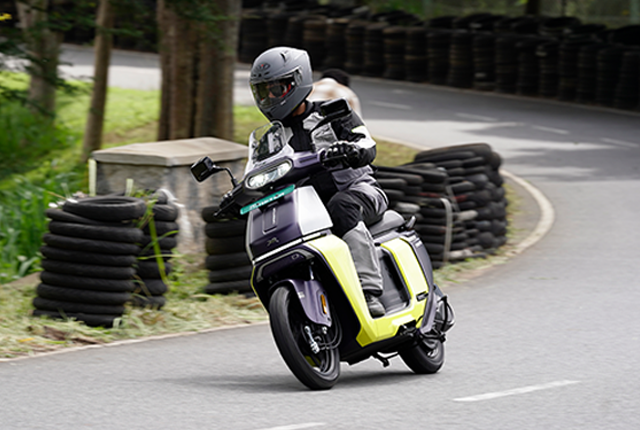
With over 6.5 lakh units sold, TVS currently rules the electric scooter segment in terms of sales. While the iQube was a raging success, the X was not as much. Will the Orbiter prove to be the brand’s third act?
Story: Abhisu Poddar
Photography: Kalidas M
The Rs 1-lakh electric scooter segment is now a super-saturated one, thanks to players like Ather, BGauss, Chetak, Honda, Kinetic, Ola, Vida… I’ll run out of my word-limit, but you get the idea. TVS, however, has managed to lead the sales chart with just two products in its portfolio, with the iQube carrying most of the burden, thanks to its conventional scooter-like design, ample space and comfort, decent features, and an accessible price tag. Now, the Hosur-based brand is looking to expand its presence with a new entry-level electric scooter.
Enter the Orbiter. New wheels, chassis, battery pack, motor—a brand-new product from the ground up, the Orbiter was never meant to be a side-kick to the iQube. Instead, it’s a superhero in its own right, being lighter by two kilograms and claiming a longer IDC range of 158 kilometres from a smaller 3.1-kWh battery. Positioned for younger buyers but designed to be practical enough for families as well, everything about the Orbiter is fresh.
I must acknowledge: it’s not easy to make straight lines look appealing. A huge departure from the iQube’s conventional scooter-like design, TVS has done a commendable job of sculpting a boxy, robotic, industrial silhouette that looks youthful and energetic at the same time. While the bodylines verge on sober minimalism, the trademark Neon Sunburst colour scheme arrests attention with its extreme maximalism: there’s no doubt the Orbiter is a funky-looking scooter that stands out amongst its more conventionally styled rivals. Worry not, there are five more shades on offer, all more toned down and subtler, which are sure to attract those who wish to remain more low-key.
For an entry-level scooter, the Orbiter is built to look premium. TVS claims all the panels on the scooter, including the windscreen, have been designed for optimal aerodynamic efficiency. Functional air-vents on the side of the scooter direct air to the battery for cooling. Wrap-around LED daytime running lights (DRL) up front and brake lights at the rear run across the width of the scooter, with the edges doubling as turn indicators, and look quite sleek and modern. However, we still found some rough edges in the panel finishing, which, we hope, TVS will address in the production units.
The “flat-form” seat on the Orbiter is positioned at a friendly 763 millimetres above the ground, and its 845-mm long flat shape means two healthy adults can comfortably hop on to the scooter. The riding position is upright and comfortable, with just enough sportiness sprinkled in to make it feel engaging at the same time. Pop the seat, and you’ll be greeted by a generous 34 litres of storage capacity underneath; enough to fit two half-face helmets, as TVS was so kind to showcase. Full-face helmets, however, still miss the memo for the basement party.
The instrument cluster is a simple 5.5-inch LCD console that, well, does the job. It features a digital readout for speed and remaining charge as well as caller ID sharing and turn-by-turn navigation via Bluetooth pairing, but misses out on the fancier TFT displays with the multitude of menus that the market offers within this price range.
Pick the electric scooter up from its stand and you’ll immediately appreciate how light the 112-kg Orbiter feels on its feet. The wide handlebar is placed at a decent height, providing good leverage to make quick turns without getting tall knees tangled. The 290-mm high floorboard is spacious, with a utility hook and a small cubby pocket where you can charge your phone on the go. The overall profile of the scooter is quite slim, which should make it easy to filter through city traffic.
An all-new hub-mounted Brushless DC (BLDC) motor producing 2.5 kW (or 3.4 hp) of peak power propels the Orbiter to a claimed 0–40 km/h in 6.8 seconds before topping out at 68 km/h. Out on the track, the outright performance came off to be a tad underwhelming. There are two riding modes: Eco and City. Both deliver identical throttle response and acceleration; however, the top speed is restricted to 45 km/h in the Eco mode. While the performance should be sufficient for our crowded city streets, riding on ring roads and highways will be a challenge, especially when you want to make quick overtakes.
One of the Orbiter’s standout features is its cruise control, though it comes with a few limitations. It can be activated only above 20 km/h, but speed caps apply depending on the mode: up to 40 km/h in Eco and 60 km/h in City. This design decision seems to be a precaution, since hub-mounted motors tend to heat up when subjected to heavy loads for a long period of time. Engaging cruise control is a two-step process: the CC button needs to be pressed twice to activate it, and it switches off the moment you accelerate or brake. The hill-hold control and parking assist work as intended, though the brake lever needs to be held for almost two seconds to engage hill-hold control. For those who prefer not to use it, hill-hold can be disabled via the display.
The Orbiter is, as is the trademark of a TVS product, a remarkable handler. The staggered 14-inch front and 12-inch rear wheel set-up ensures that the electric scooter remains stable over all kinds of roads, while being easy to manoeuvre at the same time. Flicking it through a slalom of obstacles as well as a tight serpentine course on TVS’ testing grounds was a piece of cake, so was the stability at higher speeds, and we expect it to be equally easy to navigate in real-world traffic conditions. Drum brakes at both ends, however, are a let-down when most of the competitors offer at least a front disc at this price point. The braking performance is adequate at best, with the levers feeling hard and lacking feel and feedback.
On paper, the Orbiter promises an impressive 158 km from its 3.1-kWh battery pack, one of the highest claimed figures in its class. Our short spin wasn’t enough to put that claim to test, but given its modest power and acceleration, it seems safe to expect around 100 km in everyday use. There’s only one level of regenerative braking, and it kicks in only once the battery drops below 90 per cent. Charging is a straightforward affair, but also where the Orbiter shows its restraint: it comes with a 650-watt home charger that needs roughly 4.5 hours for a full top-up. Unlike some rivals, though, there’s no fast-charging option.
TVS is betting big on the Orbiter not just replicating the iQube’s success, but outshining it. Its funky styling and relevant up-to-date features will appeal to younger riders, yet its light weight, easy manners, and overall practicality mean it could just as easily serve as a family two-wheeler. Still, there’s room for improvement. Performance and braking hardware leave you wishing for more, and a higher-spec version with the iQube’s 4.4-kW motor and a front disc brake would go a long way in plugging those gaps. The instrument cluster, too, could do with more polish, while tighter fit-and-finish would raise the overall sense of quality. With these refinements, the Orbiter has every chance of standing shoulder-to-shoulder with the iQube as a truly complete package in TVS’ electric scooter portfolio.
Also Read: VIDA VX2 Plus Review


Leave a Reply